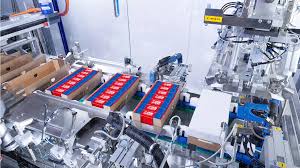Russia: Opportunities and Market Accessibility for Food Technology Exporters
An increased competitiveness of national food industry stimulates a growing demand for Food processing and Packaging Machines
Published by Matteo Olivieri. .
Industrial equipment Foreign markets Marketselection Export markets International marketing Market AccessibilityThis article was written in collaboration with Valeria Minasi, export and internationalization consultant. She collaborates with the ExportPlanning team within the International Market Accessibility project.
Embargo accelerated the development
of the Russian Food industry..
In 2014, the introduction of international sanctions and restrictive measures against the Russian Federation due to the Ukrainian crisis, brought the Russian government to implement, as a retaliation, the ban on importing certain categories of agricultural and food products - which are beef and pork, poultry, fish, cheeses and dairy products, fruits and vegetables - from the United States, Canada, Australia and EU countries.
At the same time, in recent years the Russian government has encouraged the strengthening of the national food industry, in order to increase its food independence, which could protect the domestic market from the effects of the embargo still in force 1. As the graphs below show, we report a constant increase (and an acceleration in recent years) in the domestic production of agri-business products2, both for Unpacked Food (whose production reached a record value estimated close to 11 billion euros last year3) and Packaged Food and Beverage (with a 2019 production value close to 7 billion euros4).
.. boosting the demand for machinery and equipment.
At the same time, the demand for machines for the food industry and technologies for packaging5 of food products grew up.
In 2019, Russia took third place in the ranking of the main food machinery importing countries, exceeding 1.5 billion euros. In detail, the following are worthy of note:
- 1st place as the 2019 world market for Machines for the dairy industry6 (with an incidence of the premium segments equal to 59% of market imports), Ovens, non-electric bakery7 (with a relevance of the highest price bands equal to 66% of market imports) and Skimmers8 (with premium segments even equal to 76% of the total imported);
- 2nd place (after USA) for Devices and means of recirculated cooling water9, Bakery machinery10 (with quality imports equal to 52% of the total market) and Other food machinery11 (with an incidence of imports high and medium-high price of 60% of the total).
Specific elements of Accessibility
Despite significant opportunities, the Russian market presents specific accessibility requirements for manufacturers of machinery and equipment for the food industry. Here are some references to regulations and procedures.
For a detailed analysis - also concerning about tariff barriers - please refer to the following document of the IMA-Market Report12 series:
"Accessibility of the Russian Food Machinery Market - Specific Requirements".
Compliance
The legislative developments and the technical regulations of the Customs Union have included new requirements to export machinery into the Russian market. First of all, according to the most recent technical regulations, it is important for the exporter to nominate his own representative (Applicant) which assist the company in the several certification procedures. Consequently, the conformity of the machinery must be certified in two ways:
- EAC certificate of conformity: certificate of product conformity released by a UEE certification system after an inspection visit at the production plant and after a product sample test at a UEE laboratory;
- EAC declaration of conformity: self-certification issued by one of the authorized subjects, to certify the conformity of a product to one or more applicable technical regulations, with or without intervention of a laboratory test.
Conformity marking (CTR)
The Conformity to Technical Regulation (CTR) marking is an indispensable requirement for the exportation and for products commissioning in the Russian Federation. The marking have to be placed in the following two areas:
- on the product / device label (plate);
- in section containing compliance information on product/device of the manual user, together with information on the manufacturer.
1) Last January, the Russian government decided to extend the embargo until December 31, 2020, signing a decree on the new food safety doctrine, which establishes that must be produced in the internal market at least 90% of sugar and seed oil (previously it was 80%), and not less than 85% of fish products (previously it was 80%). The other parameters have remained unchanged.
2) As a result of this fortification, the Russian agri-business trade deficit fell from -20.3 billion euros in 2014 to -8.6 billion in 2019, with a further reduction of it (-4.4 million euros estimated in the scenario in 2023, according to the ExportPlanning forecasts).
3) Within the Unpacked Food products, the major specialisations of the Russian economy - measured by a significantly positive and growing trade balance - for the production of Frozen fish (with an estimated 2019 production of 2.3 billion €), Sunflower oil, crude (more than 1.5 billion € of production value in 2019), Crustaceans, frozen (1.1 billion €).
4) Within the Packaged food and Beverage sector, the main specializations of the Russian economy - with positive and growing commercial balances - for the production of Chocolate in containers, in packages less than 2 kg (with an estimated 2019 production of 0.7 billion euros) and Sunflower oil (449 million euros production value 2019) are worth mentioning.
5) With reference to the sector of Packaging Machines, with a value of approximately 600 million euros, Russia occupies the third place in the main world import markets. In particular, there are significant positions and - above all - a high incidence of the premium-price segments for Machinery for cleaning or drying bottles or other containers (with 72% of the total imported from the market attributable to the high and medium-high bands price), Machinery for packing or wrapping (82% of "premium-price" imports) and Machinery for filling, closing, sealing or labeling (80% of "premium-price" imports).
6) See the related product's description.
7) See the related product's description.
8) See the related product's description.
9) See the related product's description.
10) See the related product's description.
11) See the related product's description.
12) See the IMA Help-Desk section of the ExportPlanning Market Research tool.


